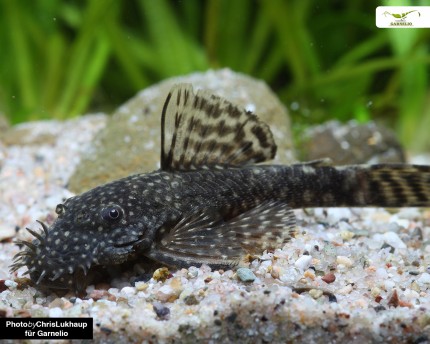incl. VAT plus shipping costs
Immediate delivery, express possible ![]()
More than 20 Articles in stock
Delivery only innh. Germany and Austria possible.
Switch to the German store
- Item no: 7611
Fast delivery times
All products are in stock with us!14 years of breeding experience
Let our team of experts advise you!High customer satisfaction
from over 3,000 reviews "| Final size: | 8-12 cm |
| Difficulty: | 1 - Simple |
| with dwarf crabs?: | Yes |
| with snails/shells?: | Yes |
| Visual effect: | Especially colorful |
| Diet: | omnivorous - omnivorous |
| Fish group: | Tooth carp |
| Water values: | Hard water |
| Pelvic region: | Top |
| Breeding: | simply |
| Aquarium size: | 100 l (approx. 80cm) |
| Planting possible?: | conditional* (see description) |
| with shrimps?: | with shrimps from 4-6 cm size |
| Origin: | Central America |
| Temperature: | 25-30 °C |
The gold dust molly is a golden and black breeding form of the molly from Central America and South America. There the Poecilia sphenops, also called pointed m olly, is widespread and lives mainly in the lower reaches of rivers to the brackish water areas of estuaries. Poecilia sphenops var. goldstaub is a robust and popular aquarium fish for an aquarium with medium to hard water. Even in brackish water the molly can be found in its native habitat. In the aquarium hobby, the beautiful and easy to keep Mollies have been established for well over 100 years. Like their relatives, the guppies, swordtails and platies, the mollies belong to the live-bearing toothcarps. The coloration of the Gold Dust Molly is quite beautiful: the front half of the body is almost pure gold and shimmers great, the abdomen on the other hand is black with gold very fine speckles that look like gold dust. The iris of the eyes is black - a great contrast.
Male Gold Dust Mollies grow to a length of 4 to 6 cm, the females grow to a length of 6 to 10 cm. An aquarium of 80 liters or more is suitable for keeping a group of Mollies. The males have an extended anal fin that functions as a sexual organ, the gonopodium. It is absent in females, and they are also much rounder in build than the male gold dust mollies.
Mollies are live-bearing toothcarps, and so Gold Dust Molly females also give birth to live fry. Gold Dust Molly females are able to store male semen for a long time after a successful mating, and so they can give birth to fry for months without having to mate again. Therefore, offspring can occur even in all-female groups. A litter has approximately 30-80 fry. However, adult Gold Dust Mollies will partially eat their offspring. In aquariums well stocked with fine-feathered plants, therefore, significantly more fry will get through, because they can hide better here.
Gold Dust Mollies are group fish and must not be kept individually. We recommend a group of 10 animals as a starting stock. Wild Poecilia sphenops live in biotopes in medium to very hard water and even partly in brackish water. In the aquarium therefore also a salt addition is conceivable. Water temperatures of 24 to 28 °C are optimal for Gold Dust Mollies. The pretty aquarium fish react quite sensitively to temperature fluctuations, therefore the changing water should be adapted to the aquarium water in terms of temperature before fresh water is added during the water change.
Gold Dust Mollies can be well socialized with Cambarellus dwarf crabs or also with larger shrimps such as Amano shrimps. Smaller invertebrates are eaten. A very robust and assertive shrimp species that copes well with hard water would be the Sulawesi Island Shrimp. With it a socialization is conceivable. It can also work with Neocaridina if the aquarium is really densely planted. However, you will not see much of the shrimp then. A socialization with larger crayfish can end with the crayfish starting to catch and eat the mollies. With other peaceful aquarium fishes, however, you can keep the large and robust Mollies practically without exception well, as long as the demands on the aquarium match.
Poecilia sphenops is an omnivore and needs besides live food and frozen food also vegetable food. It likes to pluck algae and other growth. Also water plants with soft foliage are nibbled. This can be prevented by feeding soft / scalded vegetables such as peas, tomatoes, spinach leaves, zucchini and pumpkin, but also scalded greens such as dandelion or nettle leaves . Gold dust mollies are known to be uncomplicated eaters and will also readily make do with flake food for omnivorous aquarium fish or granulated food.
Our food recommendation: The fragrant NatureHolic Guppyfeed was tailor-made for the needs of guppies and other viviparous fish in the aquarium. In addition to high-quality animal ingredients, it also contains vegetable components that benefit guppies & co. The soft granules protect the sensitive mouth of the viviparous from injuries caused by hard food grains and provide the fish with a natural feeding experience.
Our plant recommendation: For planting, use NatureHolic InVitros. These are free of snails, planarians and other unwanted co-inhabitants. Also free of algae spores, bacteria and fungi.
Expert Tip: We recommend for fish keeping the NatureHolic 3 Phase Liquid. The care set offers the best all-round protection for your animals. It ensures optimal conditions for successful breeding and keeping.
| Scientific name | Poecilia sphenops var. gold dust |
| German Name: | Gold Dust Molly |
| Difficulty level: | for beginners |
| Origin/Distribution: | South America |
| Coloration: | Anterior half of body shimmering gold, posterior body black with gold dust-like golden yellow speckles |
| Age expectancy | approx. 5 years |
| Water parameters: | GH 12 to 30, KH 5-20, pH 7 to 8.5, temperature 24 to 28 °C |
| Tank size: | from 80 l |
| Food | Omnivorous, likes to take frozen or live food and soft vegetables or greens, in addition to flake food and granulated food |
| Breeding | very easy |
| Behavior | very peaceful |
| Group size | at least 10 |
| Further information | Ten typical aquarium fish for beginners and alternatives to them, Tips for acclimating fish to the aquarium, Feeding aquarium fish properly - cheap food and what it can do |
- Item no: 7611
- EAN No.: 7427061496994
Entdecke die Garnelio Welt!
Garnelio gehört zu den größten Onlineshops für wirbellose Aquarientiere weltweit.
Viele Artikel gibt es exklusiv nur bei uns im Shop.














































The fields marked with * are required.
I have taken note of the privacy policy.